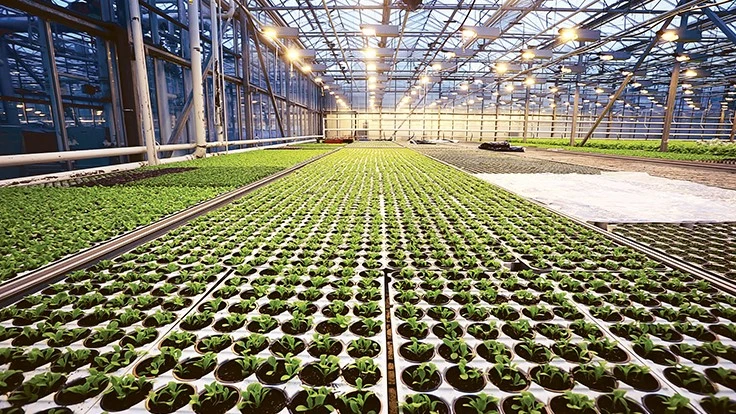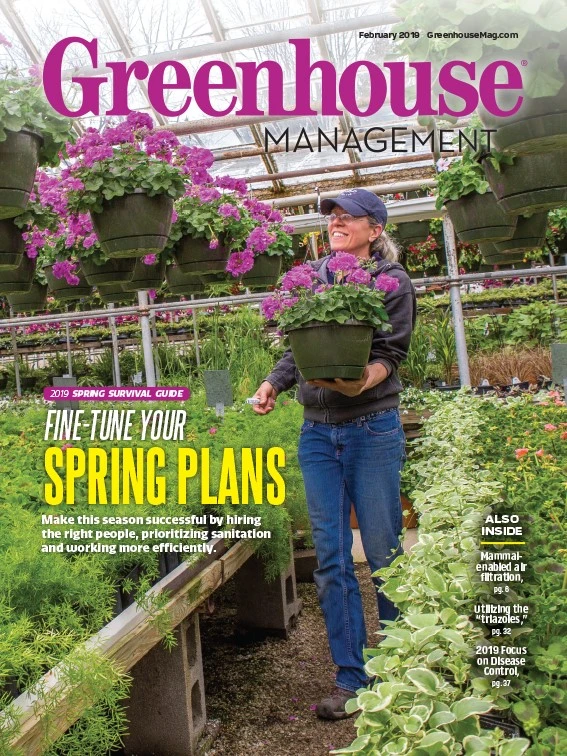
Photo: Adobe Stock

According to Kale Harbick, a research associate at Cornell University and a part of the Greenhouse Lighting and Systems Engineering Consortium (GLASE), automation’s place in the greenhouse industry, and how much new technology has become ingrained in growing, depends on how it is being evaluated.
“There’s the production automation — like moving plants around and harvesting and packing and all that,” Harbick says. “That side has seen sizeable growth. It’s much more common in Europe now, especially in the Netherlands, but some of those technologies are making their way over here. It’s kind of amazing how much labor a setup like that can save.” He adds that there are automation options to control all aspects of a greenhouse environment — such as heating, cooling and ventilation — with technology able to regulate specific light levels soon to come.
Harbick says that by correctly utilizing automation, growers can make transitioning from season to season — winter to spring, for example — easier.
“Absolutely, yes, [it can make it easier],” Harbick says. “Both on the automation side and on the control side. The relative benefit largely depends on where you are and what you are growing because the local climate can change so much. For instance: If I was growing lettuce in New York and Georgia, they would be completely different environments. They’d almost have to be totally different systems to make it work.”
Here are three ways Harbick says automation can help greenhouse operations easily transition from the cold winter to spring.

1. Automation can help combat location-based issues.
A major reason why automation technology, in addition to other growing technologies, developed was because of consumer needs, Harbick says. For example, in upstate New York where Cornell is located, produce growers need to be able to grow leafy greens and other crops in the winter because they have customers demanding locally grown, fresh vegetables year-round. On the floriculture side, greenhouses supplying independent garden centers or big box stores with spring bedding plants can’t have the beginning of their growing season delayed due to a later than expected snowfall. Similar issues could impact growers across the Midwest too, Harbick says.
“You have to have some kind of controls to be able to produce when you need to,” Harbick says. “There’s no other way to do it.”
For flower growers, he says this could mean relying on an environmental control system — technology Harbick says is developed and automated in ways other technology isn’t ready to be yet — to optimize a growing environment even when conditions are not optimal. He adds that in the future, growers will be able to automate their lights for a specific light level instead of only being able to set a minimum; GLASE is currently working to bring that technology to market after finishing its own testing with the help of growers and lighting companies.

2. Automation can help maintain a balanced environment.
Many growers primarily focus on their daily light integral (DLI), but pay little attention to the other parts of their growing environment, Harbick says. One issue that he says is common in certain houseplant varieties and greens is tip burn when growers put so much emphasis on light that it negatively impacts other environmental factors.
“I think ventilation is often a key thing that people don’t pay enough attention to,” he says. “If I’m trying to grow as fast as possible year-round, the DLI is one part of it. But it doesn’t work unless I have enough evaporative transpiration (ET) and if I don’t have enough ET, then my plants will get tip burn even if I’m meeting my light targets.”
By correctly utilizing automation, growers can make transitioning from season to season — winter to spring, for example — easier.
So how can growers get the necessary amount of ET? It’s simple, Harbick says.
“You need to control the humidity so that it’s not too humid — which means in the winter you have to ventilate a lot and ventilate enough as the season changes and maybe stays cold,” he says. “And that’s counterintuitive to a lot of growers and a lot of growers say that that’s ridiculous. But if I don’t bring that moist air out, then the plants can’t grow as fast.”
3. Automation can help reduce costs.
According to Harbick, one of the major ways growers can lose money is by being inefficient with their energy use. For instance, if a grower needs to keep using a boiler to heat their greenhouses into the spring, growers can pre-set and automate heat levels and only adjust as need be. Or, if a grower is dealing with a warmer-than-expected spring, Harbick says the right type of automation can help automate fans and keep temperatures at an ideal level and not use unnecessary amounts of energy.
Additionally, no matter what level of automation a grower is utilizing, Harbick says it’s vital to still conduct regular check-ups and maintenance to ensure a successful growing season.
“It’s important to have someone on staff or contracted out that has facilities experience,” he says. “Not every grower knows their way around this stuff. If you don’t do regular maintenance, you run the risk of catastrophic crop loss. If something breaks, are you going to be equipped to handle that situation? The answer has to be yes.”

Explore the February 2019 Issue
Check out more from this issue and find your next story to read.
Latest from Greenhouse Management
- North Carolina Nursery & Landscape Association announces new executive vice president
- Plant Development Services, Inc. unveils plant varieties debuting in 2025
- Promo kit available to celebrate first National Wave Day on May 3
- Applications now open for American Floral Endowment graduate scholarships
- Endless Summer Hydrangeas celebrates 20 years with community plantings
- Invest in silver
- Garden Center magazine announces dates for 2025 Garden Center Conference & Expo
- USDA launches $2 billion in aid for floriculture growers





